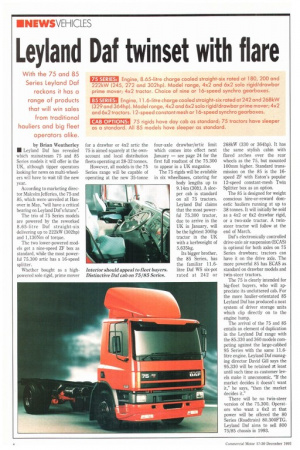Leyland Daf twinset with flare
Page 10

If you've noticed an error in this article please click here to report it so we can fix it.
With the 75 and 85 Series Leyland Daf reckons it has a range of products that will win sales from traditional hauliers and big fleet operators alike.
by Brian Weatherley • Leyland Daf has revealed which mainstream 75 and 85 Series models it will offer in the UK, although tipper operators looking for news on multi-wheelers will have to wait till the new year.
According to marketing director Malcolm Jefferies, the 75 and 85, which were unveiled at Hanover in May, "will have a critical bearing on Leyland Daf's future".
The trio of 75 Series models are powered by the reworked 8.65-litre Daf straight-six delivering up to 222kW (302hp) and 1,130Nm of torque.
The two lower-powered models get a nine-speed ZF box as standard, while the most powerful 75.300 attic has a 16-speed splitter.
Whether bought as a highpowered solo rigid, prime mover
for a drawbar or 4x2 artic the 75 is aimed squarely at the ownaccount and local distribution fleets operating at 28-32 tonnes.
However, all models in the 75 Series range will be capable of operating at the new 35-tonne four-axle drawbar/artic limit which comes into effect next January — see page 24 for the first full roadtest of the 75.300 to appear in a UK magazine.
The 75 rigids will be available in six wheelbases, catering for body lengths up to 9.14m (30ft). A sleeper cab is standard on all 75 tractors. Leyland Daf claims that the most powerful 75.300 tractor, due to arrive in the UK in January, will be the lightest 300hp tractor in the UK with a kerbweight of 5,635kg.
Its bigger brother, the 85 Series, has the familiar 11.6litre Daf WS six-pot rated at 242 or 268kW (330 or 364hp). It has the same stylish cabin with flared arches over the rear wheels as the 75, but mounted 100mm higher. Standard transmission on the 85 is the 16speed ZF with Eaton's popular 12-speed constant-mesh Twin Splitter box as an option.
The 85 is designed for weight conscious hire-or-reward domestic hauliers running at up to 38 tonnes. It will initially be sold as a 4x2 or 6x2 drawbar rigid, or a two-axle tractor. A twinsteer tractor will follow at the end of March.
Daf s electronically controlled drive-axle air suspension (ECAS) is optional for both axles on 75 Series drawbars; tractors can have it on the drive axle. The more powerful 85 has ECAS as standard on drawbar models and twin-steer tractors.
The 75 is clearly intended for big-fleet buyers, who will appreciate its uncluttered cab. For the more haulier-orientated 85 Leyland Daf has produced a neat system of driver storage units which clip directly on to the engine hump.
The arrival of the 75 and 85 entails an element of duplication in the Leyland Daf range with the 85.330 and 360 models competing against the large-cabbed 95 Series with the same 11.6litre engine. Leyland Daf managing director David Gill says the 95.330 will be retained at least until such time as customer levels make it uneconomic. "If the market decides it doesn't want it," he says, "then the market decides it."
There will be no twin-steer version of the 75.300. Operators who want a 6x2 at that power will be offered the 80 Series (Roadtrain) 80.300FIG. Leyland Daf aims to sell 800 75/85 chassis in 1993.
























































































